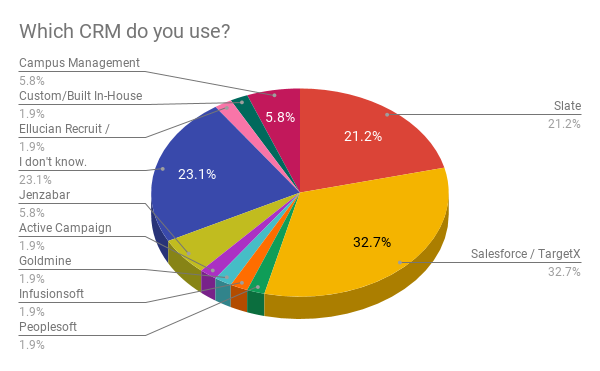So much has changed in higher education recruitment in the past decade, and these shifts are apparent in the tools used by admissions counselors.
Tri-fold brochures, postcards, and handwritten letters still have their place in a counselor’s communication tool belt. But this generation of high school students have a different set of expectations and methods of communication, which leads to counselors understandably trying to meet prospects where they are.
To gain insight into the effectiveness of modern technological tools used by admissions professionals, Formstack recently surveyed college admissions employees to get a sense of what’s being used, what’s working, and what’s not.
A look at the survey participants:
97 Survey Responses (through March 1)
- 39 Four-Year Public
- 46 Four-Year Private
- 9 Two-Year Public
- 3 Two-Year Private
The sizes of participating schools ranged from under 2,000 full-time equivalent undergrads to more than 30,000. More than half of respondents had enrollments under 5,000 undergrads, and more than a quarter had enrollments above 10,000.
The survey focused on three key areas of advancement in communication technology—social media, constituent relationship management (CRM) systems, and text-messaging systems.
Related Article: The State of Higher Ed Recruiting: Key Insights from University Recruiters
Social Media
A broad array of social media platforms are popular across the board, with colleges of all sizes and classifications reporting high usage rates of at least six different channels. If that’s not surprising, what is, at least to me, is that most platforms are used at similar rates.
Among 94 respondents who filled out the social media section of the survey:
- 90% use Facebook
- 87% use Instagram
- 85% use Twitter
- 84% use YouTube
Used less frequently among surveyed schools of all types: Snapchat (74%) and Pinterest (66%).
Had this survey been first conducted five years ago, I have a feeling the Facebook numbers would be similar, but the others would be lower, primarily due to the age of the respective channels.
Schools reported the highest engagement rates with prospective students on Instagram (a median of 8 out of 10), with Facebook and Twitter close behind (medians of 7). YouTube and Snapchat earned median engagement scores of 6, while Pinterest came in at 3.
In terms of social channels leading to website conversions—be they information requests, visit requests, applications, etc.—Facebook and Twitter came out on top with median scores of 7. YouTube and Instagram notched median scores of 6, with Pinterest (unsurprisingly) again coming in at 3.
Ultimately, there appears to be a consensus that save Pinterest, there is clearly perceived value in schools maintaining a presence on a variety of social media platforms.
Read Next: University of Nevada, Reno Increases Campus Visits to Boost Enrollment
CRM Systems
Using a CRM to collect, route, and report on prospective student data seems to have taken hold among a slim majority of surveyed schools.
A narrow 54% of respondents report using a CRM, against 46% of schools who don’t use such a system. CRM users appear entrenched in their systems, with 77% indicating adopting a CRM at least three years ago. Half of schools with a CRM have been using such a platform for five years or more.
Enrollment and classification had no impact on the likelihood of a school using a CRM or not. Among surveyed colleges with fewer than 10,000 undergraduates, the prevalence of a CRM (54%) was identical to that of larger schools.
Compared with their pre-CRM days, 67% of schools now using such systems reported a measurable improvement in their recruiting efforts.
Feedback from CRM-using schools indicated that those earlier in their adoption process of the software are still waiting to judge the CRM’s effectiveness in improving student recruitment. Many respondents also made clear that how a CRM is implemented and then utilized by staff is as important as the system’s capabilities.
One survey respondent made the usage point clear by stating, “It does the job, but I could not attribute any direct correlation of enrollment numbers to the CRM. Enrollment is impacted by how one uses the CRM and other activities.”
A few of the favorable responses regarding CRM outcomes:
“It streamlines the communication with potential students. Minimizes the risk of losing contact with prospectives.”
“There’s enormous benefit to the automation it provides.”
“It has allowed us customization of messages and better reporting”
As to CRM preference, respondents to this survey elected two primary favorites: Salesforce and Slate.
Some 33% of survey-takers use Salesforce, the largest player in the CRM space globally, while 21% use Slate, a higher-ed focused solution that has grown in popularity in recent years. No other system had more than 6% of the market share among this data set (Campus Management and Jenzabar), though a surprising 23% of those who reported using a CRM then indicated they did not know which system their school used.

CRM-using schools are generally satisfied with their current systems, with 44% reporting that they “love it” vs. 8% saying, “It’s better than nothing.” In the middle, 48% responded, “It's OK. I'd consider an alternative.”
If you're a current Salesforce user, consider checking out Formstack's Salesforce apptext messaging to seamlessly build Salesforce forms and surveys in minutes.
Text-Messaging Systems
Communicating directly with prospective students through a medium they’re largely unlikely to ignore holds a lot of appeal. Enter text-messaging platforms.
Compared to CRM solutions, texting software is newer, and corresponding has lower adoption rates and measurable impacts among surveyed schools.
Only 42% of surveyed schools have adopted a text-messaging platform, and of those, 59% have been using their systems less than two years.
Schools using text messaging are still waiting to fully gauge the return on investment, with 44% reporting no measurable gains since adding the service.
Still, anecdotal evidence is encouraging:
“Mass texting capability has been so helpful for counselors! Not sure if we can attribute it to measurable outcomes or not, but it's pretty easy to use/learn which is great for a position that tends to have such high turnover!”
“Better way to communicate because students will always check texts but not always check their email.”
“It's brand new, so not entirely sure about impact, but students are far more likely to respond to texts.”
Colleges with texting software report a pretty fragmented market. Respondents reported 12 different services, ranging from text-specific software to tools within a CRM to custom-built, in-house solutions. Also worth noting: more than half of respondents didn’t know the name of their text-messaging software.

Some college texters remain skeptical, in part due to an absence of a cohesive strategy:
“We suck at collecting data so we have no way to know its effectiveness. Plus it is not used strategically, which obviously greatly minimizes its potential to be effective.”
Checking back in a year or two from now could yield some significantly different outcomes. Stay tuned!
Conclusion
If you're wanting to increase your student enrollment, you'll need to add new and innovative solutions to your tech stack. As our survey shows, many higher ed recruiters are taking advantage of social media, constituent relationship management (CRM) systems, and text-messaging systems.
The key to reaching your recruitment goals is to put together a diverse set of tools that help you engage with prospective students. If you're looking to bring efficiency to your student engagement strategies, check out this webinar to learn how to maximize engagement across the student journey.











